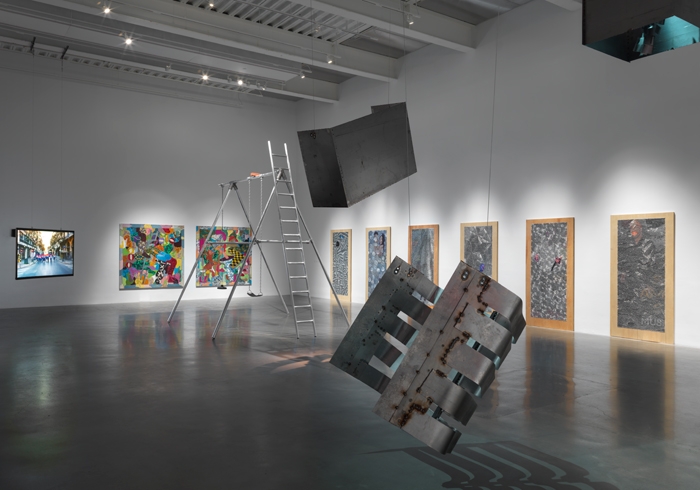I’ve noticed a lot of citations on my Instagram feed lately. Last week, a colleague posted about a poetry reading and made sure to clarify the identity of the poets (both people of colour) and that the image on the flyer pictured ‘Tommie Smith and John Carlos’ 1968 Olympics Black Power salute’. I was surprised such an iconic image would require captioning until another person I follow posted a screen capture of rap mogul Diddy’s Twitter feed, and thoroughly accounted for its origins, despite the fact the image already included the musician’s name and familiar portrait. Even memes, the lingua franca of image-sharing platforms, will often feature their creator’s water stamp, but the practice has taken on outsize political significance. The 2018 New Museum Triennial, Songs for Sabotage, seems to have trickled down from the same source, focusing its attention on artists who seek accountability from who’s looking and what’s pictured.
Curators Alex Gartenfeld and Gary Carrion-Murayari stage a handsome introduction in the fifth-floor gallery: mystifying and eloquent, harsh and foreboding, the combination of works insists on infrastructure as the exhibition’s driving metaphor. At the centre of the room is E.L.G. (2018), a monolithic swing set by Diamond Stingily. Chains dangle from fat, iodised aluminium bars, making the children’s plaything look like it belongs more in a prison yard. Inviting further injury, a prank has been prepped for any would-be swinger: a red brick is precariously positioned on the beam above the swing. Dangling in the remaining headspace, Tiril Hasselknippe’s Balconies (støp i meg støp) (2018) reduce their eponymous form to menacing steel contraptions that resemble a forensic reconstruction of an embassy bombing. Wilmer Wilson IV’s series of largescale collages, each of which obviously requires hours of labour, contribute to the feeling of claustrophobia. Layers of imagery collected from promotional materials in the artist’s neighbourhood in West Philadelphia are subsequently blanketed with staples, producing ethereal metallic embroidery patterns. In Manolis D. Lemos’s video dusk and dawn look just the same (riot tourism) (2017), the early stages of a miniriot fill the otherwise empty streets of Athens with thrilling anticipation. It devilishly captures the violence behind recent public demonstrations, and its soundtrack haunts the room.
Admittedly, the title Songs for Sabotage brought to mind holes punched in walls, documentation of museum board-members’ real estate holdings and other ways that artists might weigh in on the political fundament of the museum; anarchy that it never quite delivers. A few works still manage to operate as signposts, however, and question how to keep the museum accountable to artists’ ethical scrutiny. Lydia Ourahmane’s Finitude (2018) is tucked into an alcove in the rear stairwell that connects the fourth and fifth floors. It looks like the wall is slowly crumbling, but it is actually ash and chalk, slowly suffering the vibrations of speakers playing a low, ambient soundtrack. And I wish every museum in the US presented something like the documentary webseries What is Deep Sea Mining? (2018), by Inhabitants (Mariana Silva and Pedro Neves Marques, with Margarida Mendes), in its lobby, like the New Museum does here. A sense of catastrophe creeps into the museum experience after the video’s humble lesson succinctly informs us about the inconceivable scope of deep sea mining – a practice that “will create plumes of unpredictable consequences…”
Though the exhibition gives plenty of space to standout entries (see paintings by Manuel Solano and Janiva Ellis) and hilarious new discoveries (see Song Ta’s politically risky videowork), it does not manage to justify an overall structure that supports formal and gallery-bound work over more unwieldy activist and social practices – not to mention performance, lecture or even screening programmes that have become standard to exhibitions of this kind. This feels like a missed opportunity to bring artists more directly into the conversations surrounding their work, and to rechart institutional best-practice. Audiences gain access in these negotiations, too. But as with social media, the participants are absent from the conversation, and without them present, it can be difficult to know how to responsibly scale issues up to a global conversation or down to a local one. That the show’s curators seem to fall in line with social media policy, and step back from their own responsibility for this task, belies a cynicism or, at least, hesitation. The exhibition does little to reconfigure how we understand artistic labour, and less to reconsider how largescale international shows, and global art institutions, are accountable to artists. Ultimately, Songs for Sabotage is confined to the same old tired infrastructure.
2018 Triennial: Songs of Sabotage runs through 27 June at the New Museum, New York.
From the April 2018 issue of ArtReview
